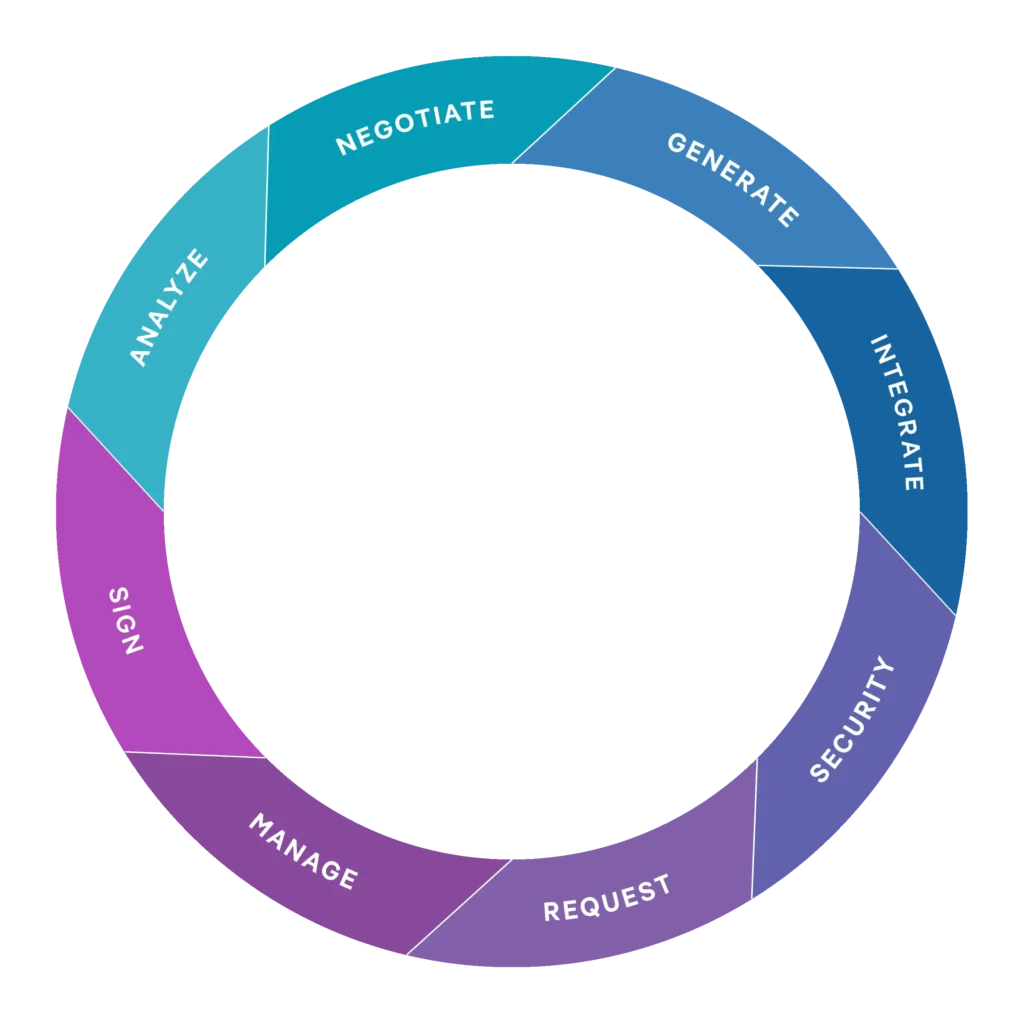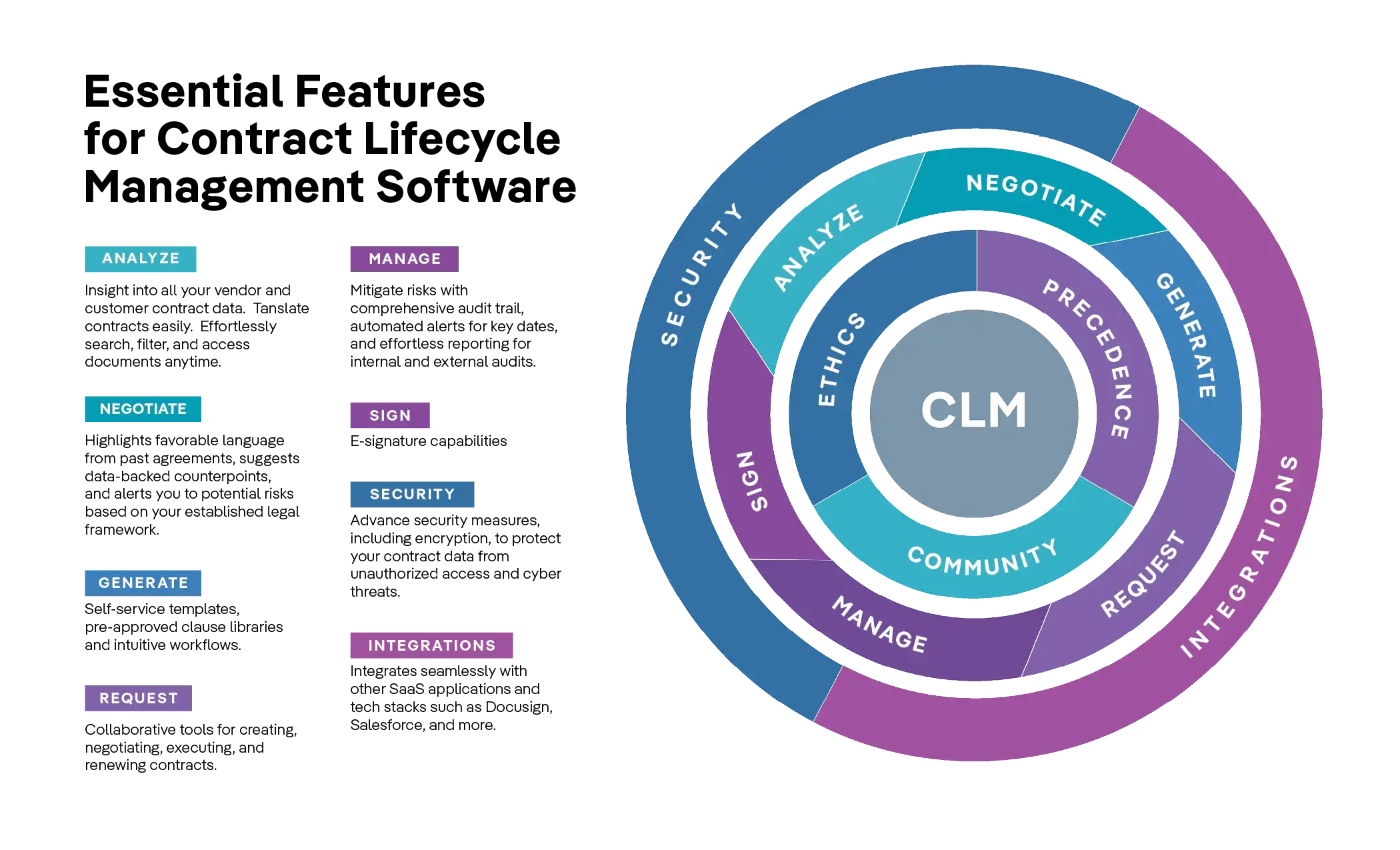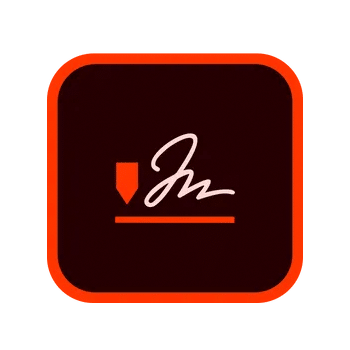What is Contract Lifecycle Management?
Contract Lifecycle Management (CLM) is the systematic process of managing an organization’s contracts
from their initial creation through execution, performance monitoring, and eventual renewal or termination.
In today’s business environment, where contracts are the backbone of revenue generation and legal compliance, efficient CLM is crucial.
The 2024 ACC Chief Legal Officers report reveals that 45% of CLOs plan to invest in new technology solutions to enhance operational efficiency in 2024, marking the highest percentage since 2021. Leading organizations use CLM systems to transform their legal operations, ensuring that contracts are managed efficiently and effectively.

The Key Stages of the Contract Lifecycle
1. Author and Generate
Contract authoring is the foundational stage of CLM, where agreements are created by compiling all necessary terms, conditions, clauses, and other essential details. This stage involves drafting documents that align with legal standards, corporate policies, and industry regulations. Effective contract management relies on the use of standardized templates and pre-approved clauses to ensure consistency and reduce the risk of errors or disputes.
Modern CLM systems often include features such as a clause library to store and retrieve standard language, version control to manage changes over time, and approval workflows that route the contract to the appropriate parties for review and sign-off. These systems streamline the drafting process, making it faster and more efficient by allowing legal teams to focus on high-value activities rather than repetitive tasks.
 2. Compliance and Review
2. Compliance and Review
Minimizing business risk and ensuring compliance with internal policies, external regulations, and industry standards are vital throughout the contract lifecycle. AI-powered CLM technology can significantly speed up the review process by automatically analyzing contracts, including those provided by third parties, to assess risks and flag non-compliant or problematic clauses.
The technology highlights language that could pose a risk to the organization and suggests alternative wording or clauses that are more favorable. Additionally, it provides a complete audit trail of changes, reviews, and approvals, ensuring transparency and accountability. This stage also involves verifying that all contractual obligations, both financial and operational, are clearly defined and agreed upon by all parties, reducing the risk of future disputes or misunderstandings.
 3. Collaborate & Negotiate
3. Collaborate & Negotiate
Negotiation is often the most time-consuming and complex stage of contract management. Effective collaboration and negotiation are critical to reaching a mutually beneficial agreement. Advanced CLM platforms facilitate real-time collaboration, allowing legal teams, business stakeholders, and counterparties to engage simultaneously, regardless of their location.
These platforms enable easy sharing and management of agreements from any device, enhancing communication and reducing delays. Features such as version control ensure all parties are working on the most up-to-date document, while workflow management allows for the automatic routing of contracts to the appropriate individuals for review or approval. Approval delegations ensure that only authorized personnel can approve changes, maintaining the integrity and consistency of the contract.
 4. Approve and Sign
4. Approve and Sign
The approval and signing stage formalizes the agreement, transforming the negotiated terms into a binding document. Digital technology revolutionizes this process by eliminating the need for physical delivery of documents, allowing contracts to be finalized quickly and securely using e-signatures. These digital signatures are legally binding in many jurisdictions and offer a higher level of security and authenticity than traditional methods.
CLM systems can support multiple signees, offer customizable cover letters, and integrate with other tools to automate the preparation and distribution of contracts. Additionally, templates and predefined approval workflows help ensure that the right stakeholders are involved at the right time, making the approval process faster, simpler, and more transparent.
 5. Manage
5. Manage
Once a contract is signed, it enters the management phase, where its terms and obligations are actively monitored and managed throughout its lifecycle. A centralized, searchable, cloud-based contract repository provides organizations with easy access to all active and archived contracts, significantly reducing the time spent searching for documents.
Smart CLM technology facilitates the comprehensive management of contract revisions, renewals, and terminations by leveraging AI engines to track obligations, risks, and key dates. Advanced natural language processing capabilities allow for the automatic identification and extraction of important data points, such as expiration dates, payment schedules, and renewal terms. Built-in alerts and notifications help ensure that no critical deadlines are missed, reducing the risk of non-compliance and financial penalties.
 6. Analyze and Report
6. Analyze and Report
Analyzing contract performance is crucial for understanding the overall health of the organization’s contracts and guiding future strategic planning. Effective reporting and analytics provide insights into various aspects of contracts, such as their alignment with business goals, performance against key metrics, and areas for improvement. AI-driven analytics tools can extract real-time information on key contract terms, such as auto-renewal clauses, expiration dates, governing laws, indemnities, pricing structures, payment terms, penalties, and liabilities.
These insights help organizations identify patterns, manage risks, and make data-driven decisions to improve their contracting processes. Regular analysis also supports compliance efforts by ensuring all contracts adhere to the latest legal and regulatory standards, reducing exposure to potential liabilities.
ROI Benefits of AI-Powered CLM
Immediate ROI Benefits
Implementing CLM software yields a swift return on investment through more efficient processes. By automating contract creation, negotiation, and approval, the time and resources needed for these tasks are significantly reduced, leading to enhanced operational productivity.
Teams can effortlessly access contracts, monitor critical dates, and maintain compliance, which minimizes errors and delays. This immediate efficiency translates to cost savings by reducing the need for manual labor and mitigating the risks of missed deadlines or non-compliance.
Future-Proofing ROI with CLM
Over the long haul, the ROI of CLM software becomes even more impactful. Research shows that poor contract management can cost companies up to 9% of their bottom line, according to World Commerce and Contracting. Ernst & Young’s research indicates that ineffective contract management can drain 1% to 5% of EBITA from a company’s earnings. The extent of these losses varies depending on the specific challenges your organization faces.
Integrating AI into contract management offers significant long-term ROI by improving efficiency, accuracy, and overall contract handling. Key benefits include:
1. Time and Cost Savings: AI can automate repetitive tasks like data entry, document review, and contract drafting, freeing up teams to focus on more strategic activities.
2. Process Acceleration: AI enhances the entire contract lifecycle—from creation through negotiation, approval, and renewal—resulting in quicker turnaround times and reduced delays, which further contributes to cost savings.
Use Cases of CLM Systems
Implementing a CLM system offers numerous benefits:
- Improved Compliance: Automated compliance tracking ensures that contractual obligations are met, reducing legal risks.
- Increased Efficiency: By automating manual tasks, CLM systems free up time for legal teams to focus on strategic initiatives.
- Enhanced Collaboration: Centralized platforms enable seamless communication between departments, improving contract accuracy and reducing approval times.
- Better Visibility: Dashboards and reporting tools provide real-time insights into contract statuses and performance.
- Cost Savings: By minimizing errors, reducing manual labor, and optimizing contract renewals, CLM systems significantly lower operational costs.
Real-world use cases include global corporations using CLM systems to streamline their procurement processes, reduce contract lifecycle times, and ensure regulatory compliance across multiple jurisdictions.
Listen to Hannah Haynes, Senior Counsel and Chief Compliance Officer at Joerns Healthcare, discuss how ContractPodAi changed their contracting process and helped her team be more efficient and transparent.
In another use case, Jeremy Korch, Assistant GC and Director of Contracts at Hays Recruiting, discusses why ContractPodAi was the solution they were looking for in a contract lifecycle management system.
Comparing CLM Solutions to Traditional Methods
Traditional contract management methods, such as those reliant on spreadsheets, email threads, and other manual processes, are often riddled with inefficiencies and errors. These approaches require substantial time and effort to track, manage, and update contracts, often resulting in disorganized files, duplicated efforts, and inconsistent record-keeping. Manual methods also make it difficult to maintain version control and enforce compliance with legal and regulatory standards, increasing the risk of errors, missed deadlines, and potential legal liabilities. Moreover, without a centralized system, stakeholders may struggle to find and access the correct contract documents, slowing down decision-making processes and creating bottlenecks.
Contract Lifecycle Management (CLM) solutions address these challenges by automating key aspects of the contract management process. Through features like automated workflows, standardized templates, and integrated compliance checks, CLM software ensures that contracts move smoothly through each stage of their lifecycle—from drafting to execution and beyond—without unnecessary delays or risks. A centralized repository provides quick access to all contracts, enhancing organization and visibility across the organization. This automation results in faster approval processes, significantly reduces the likelihood of errors, and offers enhanced security through robust access controls and audit trails. As a result, organizations can manage their contracts more efficiently, maintain compliance, and focus on more strategic business activities.
Common Challenges in Contract Management
Effective contract management is critical for organizations to maintain operational efficiency and minimize risks. However, many businesses encounter several obstacles in this area, which can hinder their ability to manage contracts effectively. These challenges include:
Inefficiencies: Manual processes are time-consuming and prone to errors, leading to delays and increased operational costs.
Compliance Risks: Failure to track obligations and deadlines can result in non-compliance with legal and regulatory requirements.
Data Security: Protecting sensitive contract data is crucial, yet traditional methods often lack robust security measures.
A 2023 survey found that only 4% of legal teams relying on manual contract management processes feel they have a strong grasp of key contractual risks, whereas 87% of businesses using automated CLM systems report improved visibility into those risks. CLM solutions address these challenges by automating processes, providing real-time compliance tracking, and ensuring that contracts are stored securely.
Key Features of Effective CLM Software

How Automation Improves Contract Management Efficiency
Automation is essential in enhancing contract management by reducing manual tasks, minimizing errors, and accelerating approval processes. By streamlining these repetitive activities, automation allows legal teams to focus on higher-value work, improving overall efficiency and productivity.
Automated workflows help contracts move seamlessly through each stage of their lifecycle, reducing bottlenecks and ensuring timely execution. Additionally, AI-driven analytics provide actionable insights that empower organizations to make proactive decisions, identify potential risks, and optimize contract performance.
The Importance of Data Security in CLM
Data security is paramount in contract management, as contracts frequently contain highly sensitive information, including confidential business details, personal data, and proprietary terms. Any breach of this information could lead to severe legal and financial consequences, such as regulatory penalties, reputational damage, and loss of business trust. Therefore, safeguarding contract data is a top priority for organizations.
Contract Lifecycle Management (CLM) software addresses these concerns by incorporating robust security features designed to protect sensitive data from unauthorized access and misuse. These features typically include advanced encryption, multi-factor authentication, and customizable access controls that restrict user permissions based on roles. Additionally, CLM solutions ensure compliance with relevant data protection regulations by maintaining rigorous standards for data privacy and security throughout the contract management process.
Benefits of a Centralized Contract Repository
A centralized digital repository is a critical component of effective contract management, providing a single, secure location for all contractual documents. By consolidating contracts in one accessible place, organizations can streamline their contract management processes, enhance visibility, and maintain better control over their contractual obligations.
A centralized repository offers numerous advantages, such as easy access for authorized users, improved organization through systematic categorization, and enhanced search capabilities with advanced tools to quickly locate specific clauses or terms. These benefits collectively aid in performance monitoring, compliance management, and overall operational efficiency.
Facilitating Compliance with Regulations through CLM Solutions
Contract Lifecycle Management (CLM) software plays a vital role in helping organizations maintain compliance with legal and regulatory requirements by automating many aspects of the compliance process. It provides tools such as automated compliance tracking, comprehensive audit trails, and real-time alerts for critical deadlines, ensuring that organizations adhere to their contractual and regulatory obligations without the risk of oversight.
By centralizing contract data and creating a structured, transparent process for monitoring compliance, CLM solutions allow organizations to quickly identify and address potential compliance risks. The software’s ability to generate detailed reports and maintain a clear audit trail of all actions taken throughout the contract lifecycle helps demonstrate compliance during audits, reducing the likelihood of legal penalties or reputational damage. Additionally, the use of automated alerts and reminders ensures that key deadlines, such as renewal dates or regulatory filing requirements, are never missed, allowing organizations to stay proactive in managing their legal responsibilities.
Improving Contract Visibility and Control with CLM Software
CLM software significantly enhances contract visibility and control by offering comprehensive dashboards and advanced reporting tools that provide real-time insights into contract statuses, key milestones, performance metrics, and compliance requirements. This level of visibility is essential for effective decision-making and proactive risk management, allowing organizations to identify potential issues before they escalate and take corrective actions promptly.
By centralizing all contract-related information and providing easy access to relevant data, CLM software empowers businesses to optimize their contract management processes, drive greater efficiency, and ensure alignment with strategic goals. Additionally, it helps organizations maintain regulatory compliance, reduce financial exposure, and strengthen overall governance over contract lifecycle management.
Fully Automated Contracting
Automate contract and risk management to increase efficiency, remove human errors, reduce cost exposure, and alleviate the strain on legal, procurement, and sales teams.
Easy Obligation Tracking
Easily retrieve delivery obligations in supplier contracts and assign tasks to business owners with the help of artificial intelligence—to track and make good on deliverables.
Complete Contract Visibility
Gain more insight into contract details and maintain control across all agreements to handle higher client contract volumes and manage a high-value supply chain.
Why do legal teams depend on CLM Software?
Embedded with AI technology, CLM software allows legal departments and companies to automate — and even accelerate — their contracting processes.
CLM software provides several key features and functionalities:
Smart Repository
Smart Repository
UX Translation
UX Translation
Self-Service Contract Creation
Self-Service Contract Creation
Workflow & Approvals
Workflow & Approvals
Esignature
Esignature
Cognitive Search
Cognitive Search
Deepsights
Deepsights
Custom Reports
Custom Reports
Integrations

Adobe Sign

Adobe Sign
Cloud-based e-signature service enabling users to send, sign, track, and manage signature processes using a browser or mobile device.

Salesforce

Salesforce
Comprehensive customer relationship management (CRM) platform enhancing sales, customer service, and marketing efforts.

Microsoft Dynamics

Microsoft Dynamics
Line of enterprise resource planning (ERP) and customer relationship management (CRM) software applications.
Hubspot
Hubspot
All-in-one inbound marketing, sales, and service platform helping companies attract visitors, convert leads, and close customers.
Docusign
Docusign
Electronic signature technology and digital transaction management service facilitating electronic exchanges of contracts and signed documents.
Central Contract Repository
Use a repository for all contracts—with built-in version management, hierarchy mapping, audit logs, and advanced search—to speed up retrieval of agreements, elevate governance, and increase negotiating power.
Automated, Dynamic Workflows
Automate pre-approved workflows, approval processes, and playbooks — for contract types, value thresholds, teams, and regions — to eliminate manual tracking of and follow-up on agreements.
Advanced Reporting & Visual Analytics
Customize reports and dashboards to display pertinent contract information. Gain overall visibility and actionable insights to make strategic, data-driven decisions.


